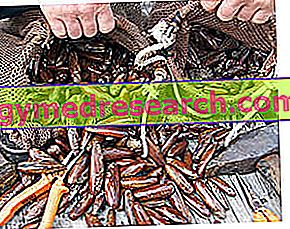What are
Sea dates are bivalve (or lamellibranch) edible molluscs. Their delicacy has made them a highly sought after and appreciated fishing product, but also protected in many areas of the planet. In Italy and other countries, sea date is in fact considered a protected species.

The sea dates, unfortunately (and now we'll see why), are a real delicacy. They are in fact characterized by a very particular ecological niche, which involves the settlement of the mollusk within the calcareous rocks; here, they erode their own housing thanks to very special acid secretions, secreted by specialized glands, in synergy with the mechanical friction exercised with the shell.
Sea dates, in general, cannot be caught without breaking the rock in which they settle and, also for this reason, their removal has become prohibited by law. The low population density (due to the extreme slowness with which they grow), and the need to disfigure the coastal coastline to extract them, have made sea date one of the lamellibranch most subject to environmental protection in the entire category.
The nutritional intake of sea dates is slightly different than that of mussels.
Description
The sea date has the shape of a narrow and long ellipse, with one of the two ends more rounded than the other. The color is dark brown with nuances of rust, it has a certain phosphorescence but inside it has a typically pearly white-light blue pigment. The sea date shell is composed of two equivalent valves that, on the outside, show clear growth lines.
Sea dates reach a size of 8-10cm, but the growth is extremely slow; take up to 20 years to finish just 5cm in length.
Sea dates have sexual dimorphism and reproduce in the summer months of July and August. The first stage of newborns is larval; they, transported by the current, tend to cling to the rocks (or shells) by means of the byssus (tuft of fiber similar to that of the mussels) which, later, will fall.
They are widespread in the Mediterranean Sea but, contrary to what is mentioned in certain bibliographic sources, their presence does NOT affect (or only marginally) the western Adriatic coast, which starts from Veneto and ends in Abruzzo.
Fishing
As anticipated, the fishing of date mussels is considered an illegal practice. Italy, even before the European Union, prohibited fishing with a ministerial decree in 1998; in other European countries it was necessary to wait until 2006 (Art. 8 EC Regulation 1967/2006).
Of the sea dates, in addition to fishing, in Italy and in Europe the trade is totally abolished (Art. 8 EC Regulation 1967/2006 with extension to 30 September 2007). The reasons are clear; as also mentioned in the current regulations, the picking of sea dates (which involves the use of pneumatic hammers or, in the small, of manual chisels):
- It involves the irreversible damage of the limestone coasts
- It can seriously affect the survival of the species.
Obviously, we are still witnessing the continuous transgression of the law that regulates the withdrawal activity; poaching operations are frequently intercepted and sanctioned, but this does not seem sufficient to eradicate the habit in the local population (especially in the areas of Sorrento and the large and small islands of southern Italy; the situation in the center-north is decidedly less problematic ).
Gastronomy and Nutritional Properties
It goes without saying that, since it is a protected species, below I will NOT report any recipe for the preparation of sea date.
Moreover, since at present the sea dates are still present in the black market of the forbidden products, above all in order to discourage their capture, I have decided to totally disregard both the advice for the purchase and the notes concerning food hygiene and storage.
I will therefore limit myself to reporting that sea dates can be prepared in a similar way to other bivalves and that "raw" consumption is also quite widespread, where the carbohydrate content is particularly evident.
How to Clean and Cook Mussels
How to Clean and Cook Clams
From a chemical-nutritional point of view, sea dates are not frequently included in the composition tables published by research institutes. Some sources, whose reliability I cannot establish, list the following parameters:
Water: 74.6g, Carbohydrates: 24.2%, Fats: 6.9%, Proteins: 68.9%, Calcium: 31.0mg, Iron: 3.19, g, Phosphorus: 190.0mg, Magnesium: 48.0mg, Manganese: 0.04mg, Potassium: 250.0mg, Selenium: 0.04, g, Sodium: 301.0mg.



